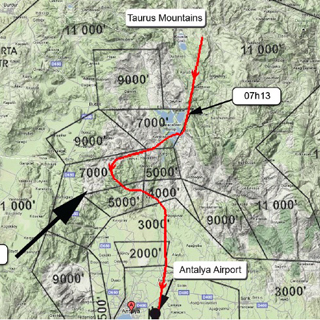
Flight path of Europe Airpost – Boeing – B737-300 (F-GFUF) flight FPO227
Europe Airpost flight FPO227 : the history of the flight is based on testimony from the pilots and analysis of the FDR parameters. The absence of the CVR recording (communications and aural warnings in the flight deck, in particular) and data from ATC (transcript of communications) along with the non-recording of some airplane parameters (invalid data or not usually recorded on the airplane type) affected the precision of the scenario.
The Boeing B737-300 registered F-GFUF, call sign FPO227, was flying the Marseille – Antalya route.
The crew began the descent at 6 h 55 UTC, after a flight of 2 h 55 min. The copilot was PF. The cabin manager confirmed to the Captain that the cabin was ready for the landing and the cabin crew has seatbelts fastened.
The crew was using the autopilot and autothrottle A/T. They stated that the onboard weather radar was being used in WX + TURB (weather + turbulence) modes.
While the airplane was flying over a broken layer of cumulus with variable development, it intercepted the let-down track of the QFU 18L VOR-DME that it captured about 50 NM from Antalya aerodrome.
The engine anti-icing was turned on at 7 h 09 min 27, descending through FL 130 at 240 kt.
A short time later, turbulence was noticed: the speed varied between 225 kt and 252 kt while the vertical accelerations varied between +0.54 g and +1.62 g and N1 between 43% and 77%.
The controller asked the crew to reduce to minimum approach speed.
The crew said that they selected 220 kt, that’s to say 10 kt more than the clean configuration manoeuvre speed at the estimated weight. At 7 h 13 min 12, the autopilot switched to altitude acquisition mode and at 7 h 13 min 19 to altitude hold at 11,000 feet. The crew stated that autothrottle A/T was in selected speed mode. The recorded indicated airspeed was 210 kt.
The crew said that they observed a relatively compact cumulus about 2.5 NM in diameter on the let-down track about 25 NM from the runway threshold; its peak being estimated at about 12,000 ft and in addition it appeared clearly on the onboard weather radar image.
While they asked for a left-side avoidance manoeuvre where the sky was less cloudy, the controller cleared them for a right-side avoidance manoeuvre. A 7 h 13 min 33 and about 30 NM from the aerodrome, the airplane that was level at 11,000 ft in clean configuration at 210 kt started a right-side avoidance manoeuvre. The autopilot was engaged in Heading mode and Altitude modes; the crew stated that bank selected on the MCP was 25°.
Autothrottle was engaged in speed hold mode and N1 was about 63.5%. Between 7 h 13 min 34 and 7 h 13 min 36, the airplane entered an area of turbulence caused by the meteorological situation (vertical acceleration varied between +0.5 g and +1.36 g).
At 7 h 13 min 38, when the indicated airspeed was 206 kt, thrust lever retard was recorded, followed by a thrust reduction; N1 reached 36.8% and 32.8% at 7 h 13 min 46 while the indicated speed was 199 kt and bank about 23°.
The thrust levers were moved forward, likely manually, a short time after a vertical acceleration of +1.45 g was recorded. The speed continued to decay while the engines responded to the throttle advance.
From 7 h 13 min 51, while the speed was 187 kt, the bank to the right increased with a very high roll rate. The crew said that they heard the GPWS “bank angle“ warning and felt the stick shaker activate. At 7 h 13 min 52 the bank angle was about 57° and increasing and N1 reached about 98% and 87%; a thrust lever retard was recorded.
Autothrottle was disengaged at 7 h 13 min 53 while the pitch decreased notably.
The recorded aileron deflection resulted from a full left Wheel deflection in order to counter the roll upset; this input being accompanied by a left deflection of the rudder. The autopilot switched to CWS Roll mode then was disconnected about two seconds later.
The bank reached its maximum of 102° to the right and the minimum speed of 181 kt was reached.
Between 7 h 13 min 36 and 7 h 13 min 51, with AP engaged, the “pitch trim“ moved from 5.5 to 6.5 while the speed was falling from 210 kt to 187 kt and the pitch was increasing from 7° to 9.5°. The bank decreased towards 90°, a value that was maintained 3 to 4 seconds, while the pitch reached –24.8° at 7 h 13 min 57 with a nose-up elevator position.
The speed increased and the descent rate was of the order of –7,000 ft/min; the crew stated that at that moment they were IMC. The bank to the right decreased then the airplane banked to the left to about 35°. The elevator deflected to nose down.
The maximum recorded descent rate during the event was about 12,000 ft/min.
The thrust levers were moved forward manually to maximum. The roll upset lasted eighteen seconds. The minimum altitude reached during the event was 7,576 ft. The crew climbed to the initial altitude of 11,000 ft and regained manoeuvring speed in clean configuration increased by 10 kt (220 kt). The autopilot, then autothrottle A/T, was reconnected at the end of the climb.
At the request of ATC, the crew described the violent phenomenon they had encountered.
After the landing, at 7 h 27, takeoffs were suspended and airplanes on arrival put in holding for about thirty minutes.
Download Report

0 Comments